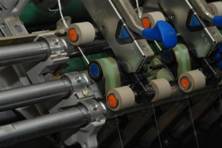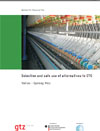|
| |
| CTC is used in this sector mainly for the cleaning of rubber cots and aprons of drawing machines, combing machines and ring-frames. |
Cots and aprons used in spinning mills are in continuous contact with fibre. Due to this contact, static electricity builds up on the surface of the cot. This attracts fibre to the cot’s surface that results in lapping. Other reasons for lapping are humidity, cotton wax, honeydew and cotton seed-oil. A list of Viable alternative solvents for spinning mills are given in the table below.
|
 |
Sl. No |
Solvent |
Sl. No |
Solvent |
1 |
Perchloroethylene |
4 |
Ethylacetate |
2 |
Xylene |
5 |
Methyl Ethyl Ketone |
3 |
NC Thinner |
|
|
Water can also be used for this application but it may increase downtime.
HAZARDS TO CONSIDER
Every substance has limitations. While every solvent is toxic to a certain extent, the harmfulness varies from one substance to another. A given substance may be hazardous on skin contact, be a fire hazard, harm the environment and / or cause cancer (i.e. red category. ). Knowledge on the hazard ratings will help industries to take appropriate preventive measures and detailed information on hazards and control measures are provided in the TA.
FURTHER INFORMATION
A detailed technical document titled "Selection and Safe Use of Alternatives to CTC - Textiles: Spinning Mills" has been published and the same is available for download.

Download the document here
|
Disclaimer
‹
Though all care has been taken while researching and compiling the information
presented above, GTZ Proklima accepts no liability for its accuracy. The
reader is advised to confirm its correctness prior to use or purchase of any
substance.
‹
GTZ Proklima makes no claim in respect of the suitability of any substance as
substitute for CTC in any specific industrial process. Suitability remains to
be verified through trials with due consideration of health and safety
aspects.
‹
Information provided here does not constitute an endorsement or recommendation
of any product by GTZ Proklima. While preference is given to non-proprietary
products information on selected proprietary products may be included if they
appear to have a better environment, health and safety performance or if they
are already widely adopted by the industry.
|
|
 |
|

